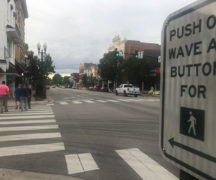From SAFE COMMUNITIES OF WOOD COUNTY
Safe Communities announced that there have been 4 fatal crashes in Wood County this year, the same amount at this time last year.
***
May is Motorcycle Safety Awareness Month, and the U.S. Department of Transportation’s National Highway Traffic Safety Administration (NHTSA) reminds vehicle drivers and motorists that safe driving and riding practices and cooperation from all road users will help reduce the number of fatalities and injuries on our nation’s highways.
Know the Facts
In 2020, there were 5,579 motorcyclists killed in traffic crashes, an 11% increase from 2019 (5,044). In contrast, an estimated 82,528 motorcyclists were injured, a 2% decrease from 83,814 motorcyclists injured in 2019. Motorcyclist deaths accounted for 14% of the total highway fatalities that year.
Research shows that motorcyclists are significantly overrepresented in traffic crashes and fatalities each year. In fact, in 2020, per vehicle mile traveled, motorcyclists were about 28 times more likely than passenger vehicle occupants to die in a motor vehicle crash and were 4 times more likely to be injured.
Motorcyclists 55-and-older accounted for 27% of motorcyclists killed in 2020. Over the 10-year period from 2011 to 2020, motorcyclist fatalities among the 55-and-older age group increased by 37%, from 1,087 to 1,486. In 2011, the average age of motorcycle riders killed in traffic crashes was 42, whereas in 2020, the average age was 43.
In 2011 and 2020, roughly half the motorcyclists were killed in traffic crashes during the weekend versus weekday. Additionally, motorcyclist fatalities on weekdays have increased by 15% from 2,402 in 2011 to 2,765 in 2020.
Tips for Motorists
- Observe all traffic laws, yielding to motorcyclists, especially while turning at intersections
- When interacting with motorcyclists, avoid distractions that place motorcyclists and other road users at risk.
- Remember, motorcycles are smaller than most vehicles and difficult to see. Their size can also cause other drivers to misjudge their speed and distance.
- Though a motorcycle is a small vehicle, its operator still has the same rights of the road as any other motorist. Allow the motorcycle the full width of a lane at all times.
- Always use a turn signal when changing lanes or merging with traffic.
- If you see a motorcycle with a signal on, remember: motorcycle signals are often non-canceling, and the motorcyclist could have forgotten to turn it off. Proceed with caution to allow the motorcyclists the opportunity to complete the maneuver.
- Check all mirrors and blind spots for motorcycles before changing lanes or merging with traffic.
- Always allow more follow distance — beyond three to four seconds — when behind a motorcycle. This gives them more time to maneuver or stop in an emergency.
- Obey the speed limit.
- Allow a motorcyclist a full lane width. Though it may seem as if there is enough room in a single lane for a motor vehicle and a motorcycle, looks can be deceiving. Share the road, but not the lane: A motorcyclist needs room to maneuver safely.
- Always signal your intentions before changing lanes or merging with traffic. This allows motorcyclists to anticipate your movement and find a safe lane position.
Tips for Motorcyclists
- Wear a DOT-compliant helmet with a “FMVSS No. 218 Certified” label and other personal protective gear. NHTSA estimates that helmets saved the lives of 1,872 motorcyclists in 2017. An additional 749 lives could have been saved if all motorcyclists had worn their helmets. Learn how to identify a safe, DOT-compliant helmet at www.nhtsa.gov/motorcycle-safety/choose-right-motorcycle-helmet.
- Never ride while impaired or distracted — it is not worth the risk of killing or injuring yourself or someone else. Plus, a DUI costs $10,000 on average, and can lead to jail time, loss of your operator’s license, and higher insurance rates.
- Always complete rider education courses and ride with a current motorcycle license. In 2020, 36% of motorcycle riders involved in fatal crashes were riding without valid motorcycle licenses.
- Obey the speed limit. Thirty-four percent of all motorcycle riders involved in fatal crashes in 2020 were speeding, compared to 22% for passenger car drivers, 16% for light-truck drivers, and 7% for large-truck drivers. Motorcycle riders 25 to 29 years old involved in fatal crashes had the highest speeding involvement at 45%.





